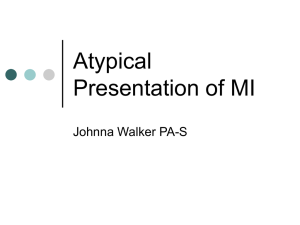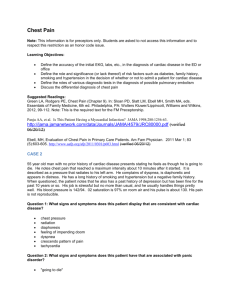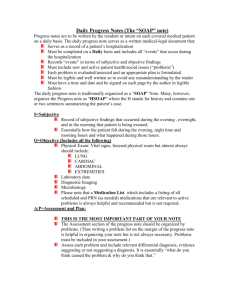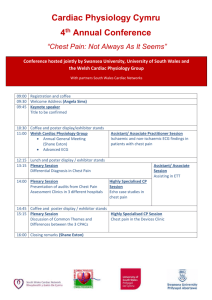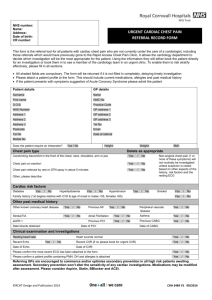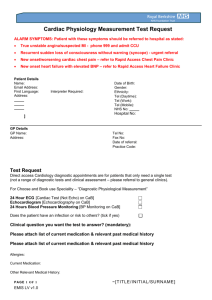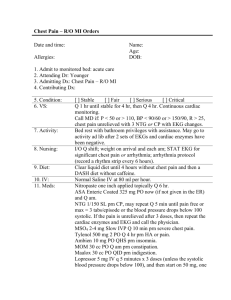心臟內科標準病歷範本-Admission Note
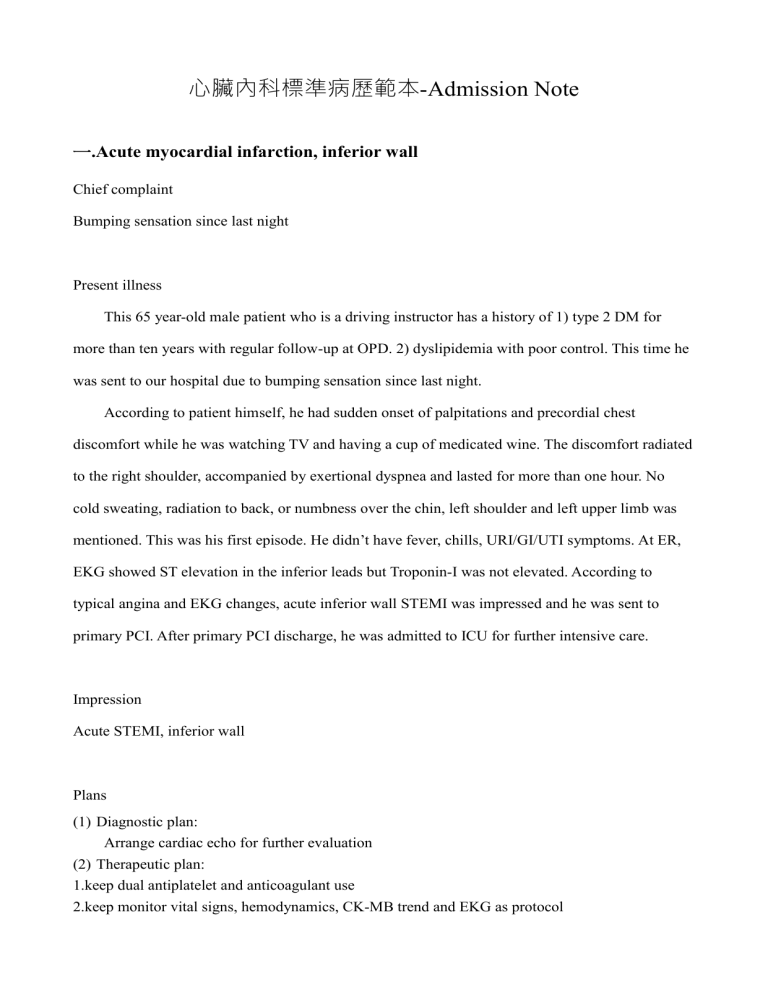
心臟內科標準病歷範本
-Admission Note
一
.Acute myocardial infarction, inferior wall
Chief complaint
Bumping sensation since last night
Present illness
This 65 year-old male patient who is a driving instructor has a history of 1) type 2 DM for more than ten years with regular follow-up at OPD. 2) dyslipidemia with poor control. This time he was sent to our hospital due to bumping sensation since last night.
According to patient himself, he had sudden onset of palpitations and precordial chest discomfort while he was watching TV and having a cup of medicated wine. The discomfort radiated to the right shoulder, accompanied by exertional dyspnea and lasted for more than one hour. No cold sweating, radiation to back, or numbness over the chin, left shoulder and left upper limb was mentioned. This was his first episode. He didn’t have fever, chills, URI/GI/UTI symptoms. At ER,
EKG showed ST elevation in the inferior leads but Troponin-I was not elevated. According to typical angina and EKG changes, acute inferior wall STEMI was impressed and he was sent to primary PCI. After primary PCI discharge, he was admitted to ICU for further intensive care.
Impression
Acute STEMI, inferior wall
Plans
(1) Diagnostic plan:
Arrange cardiac echo for further evaluation
(2) Therapeutic plan:
1.keep dual antiplatelet and anticoagulant use
2.keep monitor vital signs, hemodynamics, CK-MB trend and EKG as protocol
3.check lipid profile and add lipid-lowering agent if need
(3) Educational plan:
AMI and 心導管術後衛教
NTG medication education
二
.DX: CHF
Chief complaint exertional dyspnea for 10 days
Present illness
The 60-year-old male was a case of hypertension with regular follow up at our cardiovascular
OPD for 10 years. He has suffered from exertional dyspnea for 10 days. He described that the dyspnea occurred after he climbed two flights of stairs or heavy work initially. Easy fatigue and edema of both lower legs were also found. In these three days, he felt comfortable only at rest. No chest tightness, cold sweating, palpitations, fever, or productive cough was noted. Sometimes shortness of breath attacks occurred at night and woke him up from sleep. He did not pay too much attention to it and took it as a common cold. Unfortunately, the dyspnea became worse. He experienced shortness of breath even in the recumbent position. He visited our MER then was admitted for further evaluation and management.
Impression : Congestive heart failure with acute pulmonary edema
Plans :
1. Diagnostic plan :
1.Arrange Cardiac ehco for heart function evaluation
2.Therapeutic plan :
1.Closed monitor vital signs
2.Diuretic with Lasix given
3.Anti-hypertensive medication given
4.Follow up CXR if needed
3. Educational plan :
Water restraint
Record I/O and BW
三
.PSVT
Chief complaint palpitatins during sleep on 99/11/13
Present illness
The 54-year-old man has a history of PSVT for 20-30 years. The same episodes usually happened about 2-3 times each year, but he did not pay much attention due to a good tolerance of it and its short duration. He developed palpitations during sleep on 99/11/13, and progressive general weakness was noted. He had visited our ER where EKG showed Paroxysmal supraventricular tachycardia. Then he was referred to our OPD, where a cardiac echo was ordered and findings showed 1) No chamber dilatation 2) Adequate global Lv systolic performance 3) No pericardial effusion. Catheter ablation was suggested. Therefore, he was admitted to our ward for further evaluation and management. In addition, he has had rhinorrhea and nasal congestion in the last 3-4 days.
Impression : PSVT
Plans
1. Diagnostic plan : Arrange EPS
2.Therapeutic plan :
Monitor vital sign
Before EPS, if palpitation give Inderal and Herbesser stat
3. Educational plan :
Inform about risk of EPS
Post EPS wound education
衛教避免煙 .
酒 .
咖啡 .
茶類等刺激性食物
四
.PSVT
Chief complaint : Palpitations off and on for many years
Present illness :
This 24-year-old male patient had past history of PSVT for 7-8 years. The patient has had several episodes of palpitations. He had visited our ER once on 99-10-16. Duration for 1 hour and referred to our CV OPD cardiac echo was done and showed 1. No mitral valve prolapse. 2. No pericardial effusion. 3. Adequate LV global systolic performance 4. No chamber dilatations. The patient denied chest pain, chest tightness, cold sweating, dizziness, nausea or vomiting. His palpitations have been worse the past 2~3 months. Under doctor’s suggestion, the patient was admitted for EPS and ablation.
Impression : PSVT
Plans
1. Diagnostic plan : Arrange EPS
2.Therapeutic plan :
Monitor vital sign
Before EPS, if palpitation give Inderal and Herbesser stat
3. Educational plan :
Inform about risk of EPS
Post EPS wound education
衛教避免煙 .
酒 .
咖啡 .
茶類等刺激性食物
五
. Dx: Sick sinus syndrome
Chief complaint : Syncope this noon
Present illness
The 54-year-old male patient has a medical history of ESRD with H/D qW135 for 8 years, DM on insulin, and HTN controlled with oral antihypertensive drugs for about 10 years. He had undergone cardiac catheterization in December 2010 that revealed CAD 3-V-D. PCI was performed smoothly. After discharge, he did not take beta blocker for over one week.
Because of slow heart rate, he visited our CV OPD for follow-up today. When the doctor was interviewing him, he developed a sudden onset of loss of consciousness for seconds. An EKG was used and revealed sinus pauses without associated palpitations, chest tightness and DOE, but mild drowsy consciousness was noted.
There was no seizure or stool and urine incontinence. The consciousness recovered soon after his cardiac rhythm returned to sinus rhythm. Thus, he was admitted for management under the impression of SSS.
Impression
Syncope suspected SSS
Plans
1. Diagnostic plan :
TCP use & TPM prn
EPS study prn
Holter EKG
2. Therapeutic plan :
Monitor vital sign
On EKG monitor
3. Educational plan :
PPM 術後傷口照護及活動限制衛教
六
. AMI
Chief complaint : Chest pain developed at 12:00 am today
Present illness
This 48-year-old male patient had a history of HTN without regular medication control. He has had sudden chest pain since 12:00 am today. The pain was tight in characteristic and located near the sternum. Dizziness and SOB were noted. No radiation pain, cold sweating or vomiting was noted.
He denied any similar symptom in the past. Then he was brought to our ER for help. EKG showed
ST elevations in leads II, III and AVF. A STEMI involving the inferior wall was suspected. Primary
PCI was arranged and he was admitted to our ICU ward.
Impression
AMI ST elevation type
Plans
1. Diagnostic plan :
Arrange cardiac echo
Closed monitor viatl sign
Follow up cardiac enzyme and EKG
Follow up APTT for heparin infusion and keep APTT 1.5~2.5*
2.Therapeutic plan :
Dual antiplatelet treatment
ACEI and B-block treatment
Heparin infusion treatment
Adequate IV fluid supply
3. Educational plan :
AMI 疾病衛教及心導管術後衛教
規則服藥及回診
NTG 藥物使用
七
.
Chief Complaint:
Frequent chest pain for several months
Present illness
This 58-year-old man has stable angina pectoris controlled with regular medication prescribed in our CV outpatient clinic for six months. However, he has noted frequent episodes of effort-related chest pain in recent months and still suffered from chest pain despite antianginal medications. At the CV outpatient clinic, he was advised admission for cardiac catheterization for evaluation of severity of coronary artery disease and treatment management.
According to the patient and medical chart review, he has suffered from intermittent chest pain since six months ago and it worsened especially when lifting heavy cargo or climbing mountains. The compression-like chest pain was located in the precordial area and lasted from 5 to
10 minutes. Chest pains radiated to his lower jaw and left shoulder and were relieved by rest. So he visited our cardiovascular outpatient clinic where angina pectoris was diagnosed by history. He underwent echocardiography and treadmill exercise test to evaluate coronary artery disease.
Echocardiography showed adequate global LV performance without regional wall motion abnormality. However, the treadmill exercise test showed 2-3mm downsloping ST depression in leads V3-V6 during phase II exercise and it persisted 6 minutes into recovery phase. Initially, the chest pain could be relieved by medication and his CAD had been well controlled. However, he has been suffering from the chest pain again recently when exercising and lifting heavy cargo. He also has a history of hypertension for 5 years, which has been controlled by medication prescribed by a local doctor. He has been smoking 2 packs a day for at least 30 years. He has no family history of myocardial infarction or coronary artery disease.
Tentative diagnosis
Cresendo angina
Plans:
(1) Diagnostic plan:
1.
Arrange cardiac catheterization for further evaluation of CAD severity
2. Explain the benefit and risk of cardiac catheterization to the patient and family, including stroke, cardiac arrhythmia, acute pulmonary edema, myocardial infarction and death. Further potential treatment options shall be described including medical control, coronary percutaneous intervention and CABG.
(2) Therapeutic plan:
1.
If the CAD of patient is suitable for percutaneous coronary intervention, we shall do further intervention for him when the patient agree PCI. If the CAD of patient is suitable for CABG, we shall consult CVS doctor for further treatment when the patients agree
CABG.
(3) Educational plan:
1.
Emphasize the importance of regular medication for coronary artery disease
2.
Strong suggest to quit smoking
3.
Restrict to hypertension control
Avoid high salt diet and high fat diet.
八
.
Chief Complaint:
Sudden onset of chest pain this morning when sleeping
Present illness:
A 70-year-old man suffered sudden chest pain with cold sweating when he was sleeping this early morning. According to the patient, his chest pain was located in the precordial area with a squeezing and compressing sensation and the duration was over 30 minutes. Other associated symptoms included cold sweating and soreness radiating to the lower jaw and left shoulder. He took
NTG 1#po at home but with no relief of symptoms. He was sent to our ER this morning at 7:00.
At physical examination at the ER, a regular heartbeat and a grade 2/6 systolic murmur over apex and mild basilar rales in the bilateral lower lung field were heard; blood pressure was
150/80mmhg; heart rate was 100 beats per minute; respiratory rate was 20 per minute. A series of examinations were done at ER. 12-lead ECG showed sinus rhythm with horizontal ST-T segment depression of 2mm in leads V2-V4. Chest X ray showed cardiomegaly and mild pulmonary congestion. Elevated cardiac enzyme (CK/CKMB: 600/100 and TnI: 5.6) and impaired renal function (BUN/Cr: 50/4.0) were noted. An arterial blood gas showed a mixed respiratory alkalosis, metabolic acidosis, and oxygen saturation of 92%.
According to medical chart review, he has a history of type 2 diabetes and hypertension for several years, which have been controlled with regular medication prescribed in our endocrine outpatient clinic. Besides, he has angina pectoris, for which he received medication prescribed in our CV outpatient clinic. At ER, acute myocardial infarction was diagnosed and antiplatelet drugs
(bokey, plavix and cleoxane) and antianginal drugs (millisol and inderal) were prescribed. Oxygen was supplied to the patient via nasal cannula at a rate of 3 liter per minute. The patient and his family were informed about the critical condition and he was admitted to coronary care unit for intensive treatment.
Tentative diagnosis:
1.
Acute myocardial infarction, Non-ST elevation type, killip II
2. Impaired renal function R/O Acute renal failure
Plans:
1.
Acute myocardial infarction, Non-ST elevation type, killip II
(1) Diagnostic plan: arrange echocardiogram and follow up cardiac enzyme
(2) Therapeutic plan:
1.
prescribe anti-platelet drugs of heparin , bokey and plavix.
2.
Check aPTT Q6H and keep 1.5X~2.0X
3.
Prescribe anti-angina medication of millisol
4.
Discuss with family potential benefit and risk of cardiac catheterization and medication
control
(3) Education plan:
Inform the patient and family potential risk of acute myocardial infarction including sudden death, heart failure, fetal cardiac arrhythmia
Avoid smoking and emphasis the importance of regular medication
Diet control of avoid high salt and high fat diet
2.
Impaired renal function R/O acute renal failure
(1) Diagnostic plan:
1.
Check FeNa and FeUN , urine osmolarity , urine Na and Cr.
2.
F/U renal echo and renal function
3.
Consult nephrologist
(2) Therapeutic plan:
1.
Avoid nephrotoxicity drug
2.
Record urine output per day
3.
restrict control of hypertension and diabetes
(3) Educational plan:
1.
Emphasis the importance of sugar and blood pressure control for preservation of renal function
Avoid high salt , NSAID and Chinese herb use
